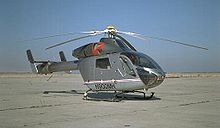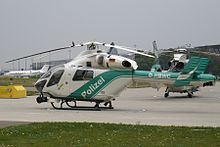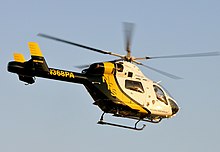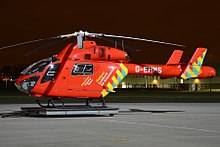MD Helicopters MD Explorer
| MD Explorer | |
|---|---|

| |
| One of London's Air Ambulance's two MD 902's in 2008. | |
| Role | Light twin utility helicopter |
| Manufacturer | McDonnell Douglas Helicopter Systems MD Helicopters |
| First flight | 18 December 1992 |
| Introduction | 1994 |
| Status | In service |
| Primary users | Mexican Navy Landespolizei Luxembourg Air Rescue Drug Enforcement Administration |
| Produced | 1992–present |
The MD Helicopters MD Explorer is a light twin utility helicopter. Designed in the early 1990s by McDonnell Douglas Helicopter Systems, it is currently produced by MD Helicopters. There have been two models, the original MD 900, and its successor, the MD 902.
Design and development[]
In January 1989, McDonnell Douglas Helicopters officially launched the development of the Explorer, initially referred to as MDX. The Explorer was the first McDonnell Douglas helicopter to incorporate the NOTAR system from its initial design.[1] McDonnell Douglas partnered with Hawker de Havilland of Australia to manufacture the airframes. 10 prototypes were built with seven being used for ground tests. McDonnell Douglas Helicopters became a launch customer for Pratt & Whitney Canada's PW200 series of engines, with an exclusive agreement to power the first 128 Explorers with two PW206As.[2] Meanwhile, plans to offer the Turbomeca Arrius as an option were dropped.[1] The first flight of the Explorer took place on 18 December 1992, with ship #2 (N900MD). FAA certification for the Explorer was granted on 2 December 1994, with JAA certification following shortly after.

In September 1997, a range of improvements were introduced, including PW206E turboshafts with higher single engine inoperative ratings, revised engine air inlets, improved NOTAR inlet design and a more powerful stabiliser control system. Benefits include improved range and endurance and an increased maximum takeoff weight. This enhanced Explorer was unofficially designated the MD 902.
In September 2000, the Explorer has been delivered with the further improved PW207E turboshaft, with improved hot and high and one engine inoperative performance.[1]
The MD Explorer features the NOTAR anti-torque system, with benefits including increased safety, far lower noise levels and performance and controllability enhancements.[1] Instead of an anti-torque tail rotor, a fan exhaust is directed out of slots in the tail boom, using the Coandă effect for yaw control. Boeing retains the design rights to the NOTAR technology despite selling the former McDonnell Douglas civil helicopter line to MD Helicopters in early 1999. The Explorer also features a bearingless five blade main rotor with composite blades, plus carbonfibre construction tail and fuselage.[1]
Variants[]
- MD 900 Explorer
- Initial Production model, powered by two Pratt & Whitney Canada PW206A (or PW206E or PW207E) turboshaft engines.
- MD 901 Explorer
- Civil utility transport model, powered by two Turbomeca Arrius turboshaft engines and tri-angel landing gear. McDonnel Douglas Helicopters announced that this type was available from serial number 127 and upwards. By sale of civil helicopter variants to MD Helicopters the type was not further developed. None ordered.
- MD 902
- Marketing name for an enhanced version with Category A approval and powered by two Pratt & Whitney Canada PW206E or PW207E.[3] Enhanced version has additional engine isolation features and changes to the Integrated Instrument Display System.[3] Older helicopters (except for the first seven built) can be modified to the enhanced version.[3]
- MH-90 Enforcer
- Armed version for the United States Coast Guard flown by the Helicopter Interdiction Tactical Squadron from 1998 to 2000.
- MD 969 Combat Explorer
- Armed helicopter version[4]
- Swift
- A high-speed compound helicopter derived from the MD 969 being developed for the US Army’s Future Attack Reconnaissance Aircraft (FARA) program.[4] Excluded from FARA in 2019.[5]
Operators[]



- Landespolizei[7]
- Luxembourg Air Rescue[10]
- Luxembourg Police[11]
- Mexican Navy[12]
- 1st Shipborne Patrol Naval Air Squadron, Mexican Naval Aviation
- Calstar[15]
- Drug Enforcement Administration[16]
- National Park Service[17]
- University of Missouri Hospital[18]
- Doctor Heli[19]
Former operator[]
- United States Coast Guard[21]
- Helicopter Interdiction Tactical Squadron 1998-2000
Specifications[]
Data from Jane's All The World's Aircraft 2003–2004[22]
General characteristics
- Crew: 1–2
- Capacity: 6 Passengers / 2,565 lb (1,163 kg) internal / 3,000 lb (1,361 kg) slung load
- Length: 32 ft 4 in (9.86 m)
- Height: 12 ft 0 in (3.66 m)
- Empty weight: 3,375 lb (1,531 kg)
- Max takeoff weight: 6,250 lb (2,835 kg) (internal load)
- 6,900 lb (3,130 kg) (slung load)
- Powerplant: 2 × Pratt & Whitney Canada PW206E turboshaft engines, 550 shp (410 kW) each
- Main rotor diameter: 33 ft 10 in (10.31 m)
- Main rotor area: 899.16 sq ft (83.535 m2)
- Blade section: - root: HH-10; tip: HH-06[23]
Performance
- Cruise speed: 134 kn (154 mph, 248 km/h) at sea level
- Never exceed speed: 140 kn (160 mph, 260 km/h)
- Range: 293 nmi (337 mi, 543 km)
- Service ceiling: 17,500 ft (5,300 m)
- Hover ceiling IGE: 11,000 ft (3,400 m) at International Standard Atmosphere
- Rate of climb: 1,000 ft/min (5.1 m/s)
See also[]
Related development
Aircraft of comparable role, configuration, and era
- AgustaWestland AW119 Koala
- Bell 427
- Bell 429 GlobalRanger
- Eurocopter EC135
- Eurocopter EC145
- HAL Dhruv
- HAL Light Utility Helicopter
- MBB/Kawasaki BK 117
- Mitsubishi MH2000
Related lists
References[]
- ^ a b c d e Frawley, Gerard: The International Directory of Civil Aircraft, 2003-2004, page 156. Aerospace Publications Pty Ltd, 2003. ISBN 1-875671-58-7
- ^ Warwick, Graham. "Rotorcraft Power: PW206A described.". Flight International. periodical. 13–19 July 1994. Retrieved on 11 October 2009.
- ^ a b c Federal Aviation Administration Type Certificate Data Sheet H19NM
- ^ a b Reim, Garrett (March 6, 2019). "HAI: MD Helicopters developing winged MD902 as US Army scout". FlightGlobal. Reed Business Information Limited. Retrieved March 6, 2019.
- ^ FaraSwift, Garrett (July 2, 2019). "HAI: MD Helicopters excluded from FARA scout". FlightGlobal. Rotary and Wing. Retrieved July 2, 2019.
- ^ http://www.belgian-wings.be/webpages/navigator/Photos/MilltaryPics/post_ww2/McDonnell%20Douglas%20MD900%20Explorer/McDonnel%20Douglas%20MD900%20Frontpage.html[dead link]
- ^ "Landespolizei MD 900". Retrieved 1 March 2013.
- ^ "ORFK". index.hu. 25 March 2016. Retrieved 25 March 2016.
- ^ "Heliservices About Us - MD902 Explorer". www.heliservices.com.hk. Archived from the original on 20 April 2015. Retrieved 24 March 2015.
- ^ "Luxembourg Air Rescue - fleet". .lar.lu. Archived from the original on 4 March 2016. Retrieved 1 March 2013.
- ^ "Grand Ducal Police LX-PGA". aeroboek.nl. Retrieved 1 March 2013.
- ^ "MD902 serial MP-032 Mexican Navy". aeroflight.co.uk. Retrieved 1 March 2013.
- ^ "Essex Air Ambulance G-EHAA". essexairambulance.uk.com. Retrieved 11 May 2015.
- ^ "The Helicopter". London's Air Ambulance. Archived from the original on 24 July 2013. Retrieved 1 May 2013.
- ^ "CalStar - Fleet". calstar.org. Retrieved 1 March 2013.
- ^ "DEA N5646". aeroboek.nl. Retrieved 1 March 2013.
- ^ "Helicopter Training Academy". nps.gov. Retrieved 1 March 2013.
- ^ "Helicopter Service". mymuhealth.org. Retrieved 21 February 2014.
- ^ Aero Asahi CORPORATION & CHIBA HOKUSHOH HOSPITAL ACHIEVE 10,000 HEMS MISSIONS EXCLUSIVELY BY MD 902 EXPLORER
- ^ "Our helicopters". cornwallairambulancetrust.org. Retrieved 4 February 2018.
- ^ "USCG MD900 Explorer". Retrieved 1 March 2013.
- ^ Jackson 2003, pp. 679–680.
- ^ Lednicer, David. "The Incomplete Guide to Airfoil Usage". m-selig.ae.illinois.edu. Retrieved 16 April 2019.
- Jackson, Paul. Jane's All The World's Aircraft 2003–2004. Coulsdon, UK: Jane's Information Group, 2003. ISBN 0-7106-2537-5.
External links[]
| Wikimedia Commons has media related to MD Explorer. |
- 1960s United States helicopters
- 1960s United States civil utility aircraft
- MD Helicopters aircraft
- NOTAR helicopters
- Twin-turbine helicopters
- Aircraft first flown in 1992